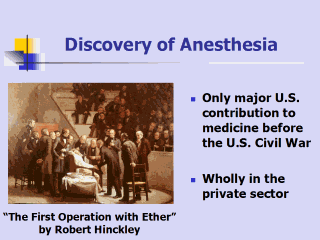| front |1 |2 |3 |4 |5 |6 |7 |8 |9 |10 |11 |12 |13 |14 |15 |16 |17 |18 |19 |20 |21 |22 |23 |24 |25 |26 |27 |28 |29 |30 |31 |32 |33 |34 |35 |36 |37 |38 |39 |review |
 |
The on major and
dramatic "breakthrough" in medicine made in the United States before the
Civil War was the discovery of anesthesia. Three separate individuals made
the discovery independently about the same time, and the argument still
continues over who should be awarded priority. This discovery was made
wholly within the private sector, however; the federal government played no
role in this research. (Note on painting): William Thomas Green Morton, one of three claimants to the discovery of anesthesia, is the tall man on the left near the patient. The tall man on the right near the patient is Henry Jacob Bigelow, who was probably responsible for the planning and success of the event in 1845 in Boston demonstrating surgery with ether. Hinckley's painting was completed some 47 years after the actual event so the individual portraits bear little resemblance to the supposed original participants. Further, Hinckley included some individuals not present while others who might have been there were not depicted. |